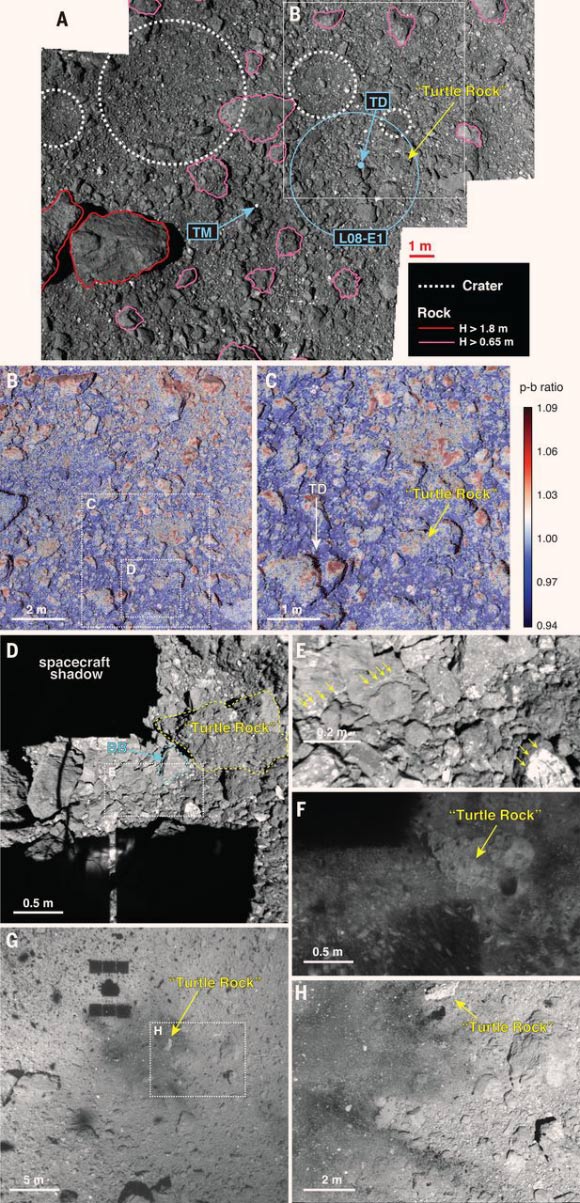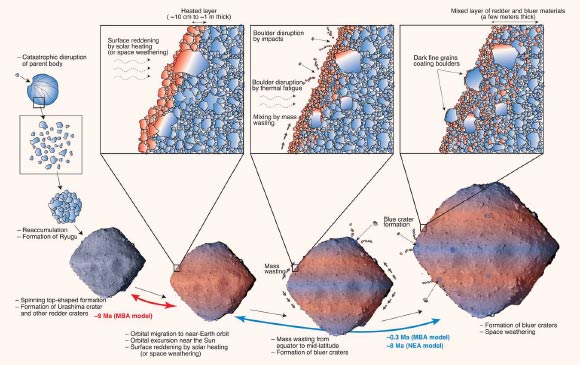JAXA’s Hayabusa-2 spacecraft recently traveled to the near-Earth asteroid (162173) Ryugu to collect samples and return them to Earth for lab analysis. Close-up images and video taken during the sampling process allowed an international team of researchers to investigate the asteroid’s surface colors and morphology.

This image of the asteroid Ryugu was captured by the Optical Navigation Camera – Telescopic (ONC-T) on JAXA’s Hayabusa-2 spacecraft on June 26, 2018, from a distance of 13.7 miles (22 km). Image credit: JAXA / University of Tokyo / Kochi University / Rikkyo University / Nagoya University / Chiba Institute of Technology / Meiji University / Aizu University / AIST.
Ryugu is a primitive carbonaceous asteroid that contains hydrated minerals and organic molecules.
Hayabusa-2, a sample-return mission to Ryugu, was launched on December 3, 2014 and arrived at the asteroid on June 27, 2018.
On February 21, 2019, the spacecraft conducted its first sample collection from Ryugu, performing a touchdown on the surface.
During the touchdown operation, Hayabusa-2 took images of Ryugu’s surface with resolutions reaching 1 mm/pixel.

Touchdown site before, during, and after the touchdown operation: (A) boulder and crater map around the touchdown site L08-E1; the light blue arrows indicate the location of the target marker (TM) and the touchdown point of the sampler horn (TD); the light blue circle indicates the L08-E1 area; the white dashed circles indicate craters; boulder heights (H) were estimated from their shadow lengths; those with H > 1.8 m are outlined in red and those with H > 0.65 m are outlined in pink; the boulder nicknamed Turtle Rock is indicated by the yellow arrow; the white box indicates the region shown in later panels; (B and C) p-b ratio images calculated from b- and p-band images obtained during the touchdown rehearsal operation, from two different altitudes; the dashed boxes in (B) indicate regions shown in the other panels; (D) an image obtained during the spacecraft’s descent before the touchdown; the dark, ragged Turtle Rock and an example of bright boulders (BB) with smooth surfaces are outlined in yellow and cyan dashed lines, respectively; the white dashed box indicates the area shown in (E); (E) close-up of the image in (D), with yellow arrows indicating fresh bright spots at corners and a possible broken plane of a boulder; (F and G) images obtained 7 and 47 s after the touchdown, showing debris lifted from the surface; (H) ul-band image obtained at 76-m altitude after the touchdown; Turtle Rock was lifted clear of the surface by the exhaust from Hayabusa2’s RCS thrusters, indicated by the yellow arrows in (F) to (H). Image credit: Morota et al, doi: 10.1126/science.aaz6306.
“Ryugu’s surface is composed of two different types of material, one slightly redder and the other slightly bluer. The cause of this color variation, however, remained unknown,” said Dr. Tomokatsu Morota from the University of Tokyo and Nagoya University and colleagues.
“Hayabusa-2’s onboard cameras captured high-resolution observations of the surface surrounding the landing site in exceptional detail, including the disturbances caused by the sampling operation.”
The researchers analyzed these images to investigate the geology and evolution of Ryugu’s surface.
Unexpectedly, they observed that Hayabusa-2’s thrusters disturbed a coating of dark, fine-grained material that appeared to correspond with the surface’s redder materials.

A schematic illustration of suggested evolution of Ryugu: surface reddening occurred within a short period after the emplacement of red craters and before the formation of blue craters; Morota et al interpret the cause of the surface reddening as solar heating that occurred while Ryugu came temporarily closer to the Sun than on its present orbit; between the formation of Ryugu’s spinning-top shape and the surface reddening, the researchers estimate a time of 9 million years on the basis of size-frequency distributions (SFDs) of red craters; from the SFDs of blue craters, the age of the surface reddening is estimated to be 0.3 million years using the main belt collision-frequency model and 8 million years using the near-Earth asteroid collision-frequency model; the scientists interpret these estimates as upper and lower age limits for the surface reddening; after the surface reddening event, the redder materials were disrupted and redistributed by impacts, thermal fatigue, and mass wasting from the equator to mid-latitude regions; a layer of mixed red and blue material subsequently formed on Ryugu’s surface. Image credit: Morota et al, doi: 10.1126/science.aaz6306.
“We suggest that a surface reddening event within a short period of time could be explained if Ryugu underwent a temporary orbital excursion near the Sun, causing higher surface heating,” the scientists said.
“Such solar heating is consistent with the apparent deficiency of carbonaceous asteroids with evidence of aqueous alteration in the near-Earth asteroid population.”
“However, solar heating on Ryugu during an orbital excursion cannot account for the low abundance of hydrous minerals revealed by global observations, because the bluish or brighter areas on Ryugu, which did not experience the intense solar heating, also have a low abundance of hydrous minerals.”
“The large local variations in the spectral slope and albedo within the sampling site on Ryugu suggest that both bluer and redder components were likely collected during the touchdown of Hayabusa-2,” they added.
“We predict that the returned sample will contain a mix of altered and unaltered materials, with the former recording a solar heating event.”
The findings appear in the journal Science.
_____
T. Morota et al. 2020. Sample collection from asteroid (162173) Ryugu by Hayabusa2: Implications for surface evolution. Science 368 (6491): 654-659; doi: 10.1126/science.aaz6306







